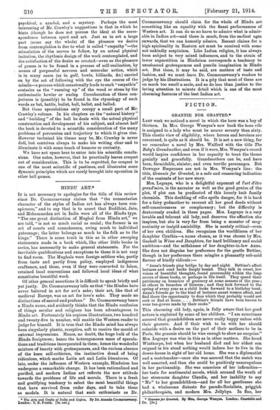THE BALL.*
IN this little volume Mr. Crawley attacks a subject which, as a good all-round athlete, a skilful writer, and something more than a student of philosophy, he is eminently qualified to elucidate. In his first chapter he writes of the "sentiment," or rather (to discard his own title) the aesthetics, of the ball. He treats the bat (the term is used generically) as an extension of the arm, increasing its radius and multiplying its force, a kind of solidified will-power, and the ball as an artificial focus of concentration, gathering into itself, like a "receiver," every movetuent and idea of the players, and in turn radiating out what it receives. Or he conceives the ball as an enemy, the striking of which arouses and satisfies primaeval instincts of combat; or, again, it is a trophy (as in football) to be con- tended for by the opposing parties. Nay, more, it is emblematic of man himself (witness the famous myth of Aristophanes in the Symposium), of the sun, of the universe it is magic, • The Book of the BO. By d. E. Crawley. London Methuen au De. set.] psychical, a symbol, and a mystery. Perhaps the most interesting of Mr. Crawley's suggestions is that in which he hints (though he does not pursue the idea) at the corre- spondence between sport and art. Just as in art a large part (some say the whole) of the pleasure we derive from contemplation is due to what is called "empathy "—the stimulation of the nerves to follovr, by an actual physical imitation, the rhythmic design of the work contemplated, and the satisfaction of the desire BO created—even so the pleasure of games is to be found in a process of self-realization, by
• means of purposeful nervous and muscular action, which is in many cases (as in golf, bowls, billiards, &a) carried on by the act of following with the eye the course of the missile—a process which occasionally leads to snob" empathic" ecstasies as the "running up" of the wood or stone by the enthusiastic bowler or curleit Corroboration of these con- jectures is (possibly) to be found in the etymology of such words as bat, battle, bullet, ball, ballet, and ballad.
But these speculations only occupy a small part of Mr. Cravrley's volume. In his chapters on the "natural history" and " building " of the ball he deals with the actual physical construction and development of his subject, and almost half the book is devoted to a scientific consideration of the many problems of percussion and trajectory to which it gives rise. However technical his theme may be, Mr. Crawley is never dull, but contrives always to make his writing clear and to illuminate it with some touch of humour or curiosity.
We have not space here to enter into his scientific condo- aims. One notes, however, that he practically leaves croquet oat of consideration. This is to be regretted, for croquet is one of the most scientific of pastimes, and illustrates some dynamic principles which are rarely brought into operation in other ball games.















































 Previous page
Previous page